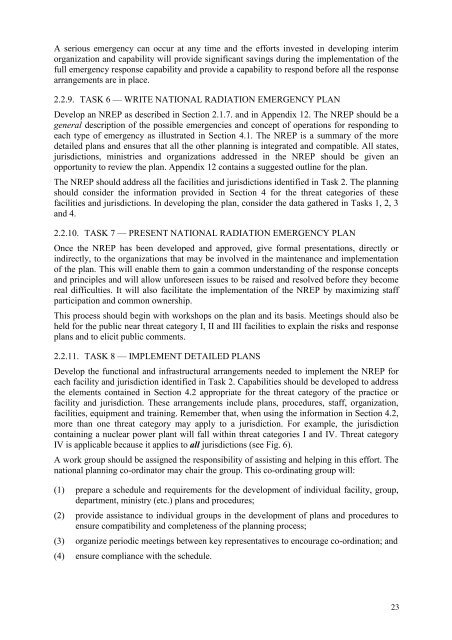epr-method (2003) - IAEA Publications - International Atomic Energy ...
epr-method (2003) - IAEA Publications - International Atomic Energy ...
epr-method (2003) - IAEA Publications - International Atomic Energy ...
Create successful ePaper yourself
Turn your PDF publications into a flip-book with our unique Google optimized e-Paper software.
A serious emergency can occur at any time and the efforts invested in developing interim<br />
organization and capability will provide significant savings during the implementation of the<br />
full emergency response capability and provide a capability to respond before all the response<br />
arrangements are in place.<br />
2.2.9. TASK 6 — WRITE NATIONAL RADIATION EMERGENCY PLAN<br />
Develop an NREP as described in Section 2.1.7. and in Appendix 12. The NREP should be a<br />
general description of the possible emergencies and concept of operations for responding to<br />
each type of emergency as illustrated in Section 4.1. The NREP is a summary of the more<br />
detailed plans and ensures that all the other planning is integrated and compatible. All states,<br />
jurisdictions, ministries and organizations addressed in the NREP should be given an<br />
opportunity to review the plan. Appendix 12 contains a suggested outline for the plan.<br />
The NREP should address all the facilities and jurisdictions identified in Task 2. The planning<br />
should consider the information provided in Section 4 for the threat categories of these<br />
facilities and jurisdictions. In developing the plan, consider the data gathered in Tasks 1, 2, 3<br />
and 4.<br />
2.2.10. TASK 7 — PRESENT NATIONAL RADIATION EMERGENCY PLAN<br />
Once the NREP has been developed and approved, give formal presentations, directly or<br />
indirectly, to the organizations that may be involved in the maintenance and implementation<br />
of the plan. This will enable them to gain a common understanding of the response concepts<br />
and principles and will allow unforeseen issues to be raised and resolved before they become<br />
real difficulties. It will also facilitate the implementation of the NREP by maximizing staff<br />
participation and common ownership.<br />
This process should begin with workshops on the plan and its basis. Meetings should also be<br />
held for the public near threat category I, II and III facilities to explain the risks and response<br />
plans and to elicit public comments.<br />
2.2.11. TASK 8 — IMPLEMENT DETAILED PLANS<br />
Develop the functional and infrastructural arrangements needed to implement the NREP for<br />
each facility and jurisdiction identified in Task 2. Capabilities should be developed to address<br />
the elements contained in Section 4.2 appropriate for the threat category of the practice or<br />
facility and jurisdiction. These arrangements include plans, procedures, staff, organization,<br />
facilities, equipment and training. Remember that, when using the information in Section 4.2,<br />
more than one threat category may apply to a jurisdiction. For example, the jurisdiction<br />
containing a nuclear power plant will fall within threat categories I and IV. Threat category<br />
IV is applicable because it applies to all jurisdictions (see Fig. 6).<br />
A work group should be assigned the responsibility of assisting and helping in this effort. The<br />
national planning co-ordinator may chair the group. This co-ordinating group will:<br />
(1) prepare a schedule and requirements for the development of individual facility, group,<br />
department, ministry (etc.) plans and procedures;<br />
(2) provide assistance to individual groups in the development of plans and procedures to<br />
ensure compatibility and completeness of the planning process;<br />
(3) organize periodic meetings between key r<strong>epr</strong>esentatives to encourage co-ordination; and<br />
(4) ensure compliance with the schedule.<br />
23

















